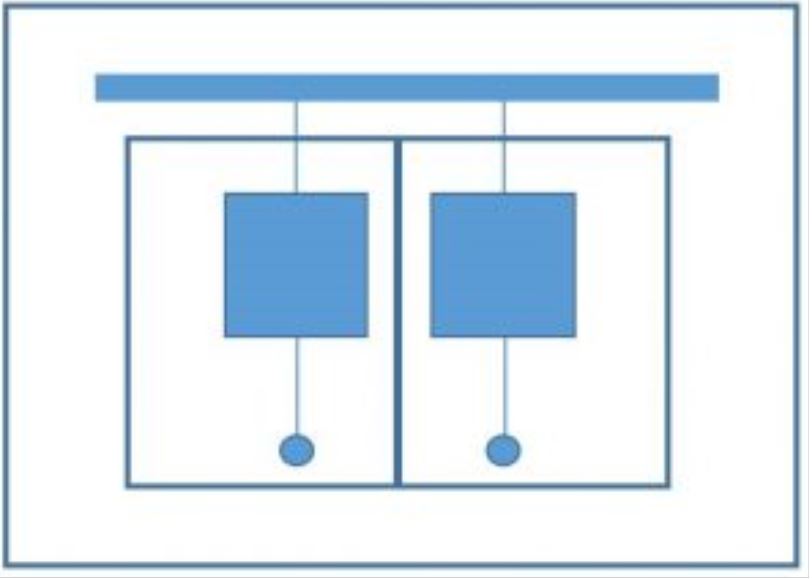隔离形式在设计中起着重要作用 电气配电板. 它们提供屏蔽,防止接触相邻功能单元中的带电部件。
您将根据所需的保护、相关人员的技能以及所需的可维护程度来确定表单面板类型。
Form 4b 面板的组件
4b 型面板有助于隔离端子、母线和功能单元,每个描述如下:
- 母线 指的是可以连接多个电路的低阻抗导体。
- 主母线 指可以连接一个或多个配电母线、输出单元或输入单元的母线。
- 配电母线 位于一个隔间内,该隔间与主母线相连,您可以从那里连接传出或传入单元。
- 功能单元 是由有助于实现类似作用的机械和电气元件组成的组装部件。
- 进线单元是指向4b型面板组件提供电源的功能单元。
- 输出单元是向输出电路输送电力的功能单元。
- 端子 提供母线与进出电缆的耦合。
4b 型面板需要提供不低于 IP2X 的防异物进入保护和不低于 IPXXB 的接触保护。

种族隔离形式的组成部分
Form 4a 面板与 Form 4b 面板之间的差异
形式4是隔离形式的最高等级。母线与外部电缆终端和功能单元是分开的。
而且各个功能单元之间是相互隔离的。
表格 4 面板主要有 2 个类别,包括:
表格 4a
在这种隔离形式中,外部电缆端子与相应的功能单元位于相似的部分。
但它们与其他功能单元的终端是分开的。
您可以使用涂层、包裹或绝缘覆盖套管来实现母线隔离。

表格 4a 分离
表格 4b
对于 4b 型面板,外部布线端子不位于同一区段作为相应的功能单元。
母线、端子、功能单元均完全相互隔离。
就像在 4a 型面板中一样,您可以通过使用涂层、包裹或绝缘覆盖套管来实现母线隔离。

表格 4b 面板隔离
4b 型面板类型
所有 Form 4b 面板都需要终止所有相关的外部导体、中性线以及隔间内的两条线。
您不会发现这些外部接线端子与所链接的功能单元位于同一隔间内。而且,它们与其他功能单元的端子隔离。
Form 4b 面板的不同类型包括:
表格 4b 类型 4
这里,母线的隔离是通过绝缘覆盖层实现的,并且需要隔离;
- 母线远离功能单元。
- 功能单元彼此独立。
- 外部电缆端子由其功能单元、母线排和其他端子组组成。
其余所有类型的分离形式均与 4b 型 4 类似,主要区别在于分离方法。

表格 4b 第 4、5 和 6 类
类型 5 需要使用屏障和隔板对母线进行隔离,并使用绝缘覆盖层隔离出口端子。
类型 6 要求使用屏障和隔板将端子和母线分开。
类型 7 每条线路需设置独立、一体化的电缆密封装置,通过屏障、隔板实现延伸端子与母线的隔离。

表格 4b 类型 7 面板
使用 Form 4b Panel 的优势
4b 型面板的主要功能是保护操作员或安装人员免受任何电气危险。
这种分离形式可以保证操作员的安全访问,从而保证以下几点:
- 防止接触相邻功能单元的带电部件。防护等级应不低于IPXXB。
- 屏蔽固体异物从一个组装单元移动到附近的单元。防护等级需不低于 IP2X.
- 降低引起或扩散内部电弧的风险。
4b 型 6 号 (成组安装) 与 4b 型 6 号 (分隔式)
表格 4b 类型 6(分隔)
这种 4b 表格面板需要隔离:
- 母线远离功能单元
- 功能单元彼此之间
- 用于从母线和其他端子进行外部接线的端子。
下图为典型的 4b 型 6 面板分隔图。

表格 4b 类型 6(分隔)面板
4b 型 6 类 (集体安装)
通过分组安装 4b 型 6 面板,您可以使用整体设备外壳作为隔离机制。
分离按如下方式实现:
- 通过刚性屏障隔离母线
- 功能单元利用整体外壳相互隔离。
- 相互隔离的外部端子及相关功能单元。

4b 型 6 类(成组安装)面板
何时使用 Form 4b 面板
如果必须保护内部带电元件免受影响,则应使用 4b 型隔离板。此外,在应用中,如果从类似母线供电的功能单元发生故障,则会导致不可接受的中断。
这种分离形式隔离了所有的终端,您可以隔离并在一个功能单元上进行操作。
Form 4b 面板构造
为了达到 4b 型额定值,您可以使用非金属或金属物理屏障来隔离母线、端子和功能单元。
尽管如此,您也可以采用更简单且更实惠的替代技术来实现隔离:
整体住宅
当功能单元外壳具有IP2X防护等级时,可用于在功能单元之间提供内部隔离。
但这种分离方法不适用于母线。
该技术适用于 Form 4b 面板,因为它涉及将功能单元彼此分离。此方法通过 Form 面板评级的后缀“h”表示,例如 Form 4bh。
端子或母线绝缘
同样,您可以使用绝缘方法将母线与端子和/或功能单元隔离。
此外,还可以遮盖终端,以与其他功能单元的终端隔离。
在这种分离方法中,您使用后缀“i”来表示它,例如,Form 4bi 面板。
绝缘和外壳的组合
此外,还可以将组件外壳和绝缘层混合在一起,以提供内部隔离。
当您应用这两种技术时,您可以通过添加后缀“I”和“h”来表示,例如 Form 4bih。
对于您的所有问题或咨询 电气外壳面板, 立即联系 KDMSteel.


